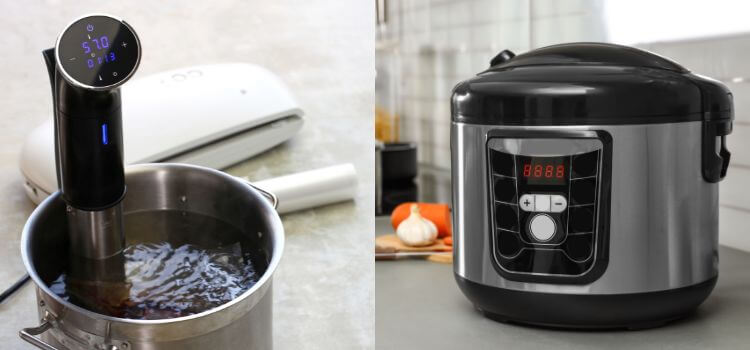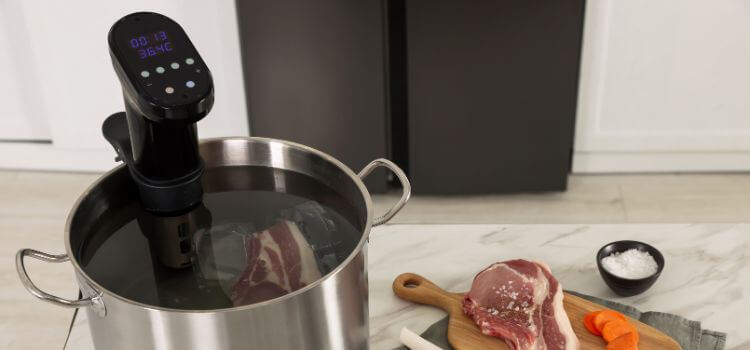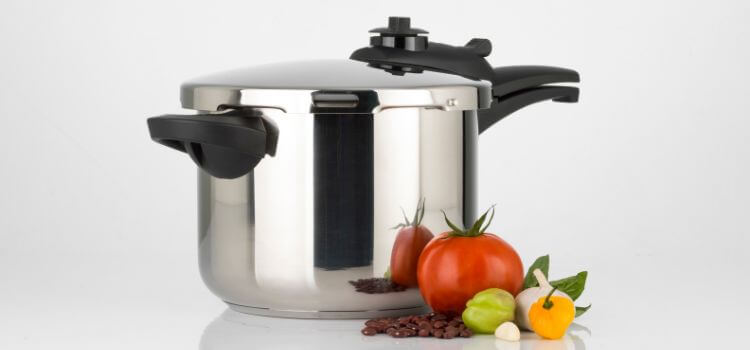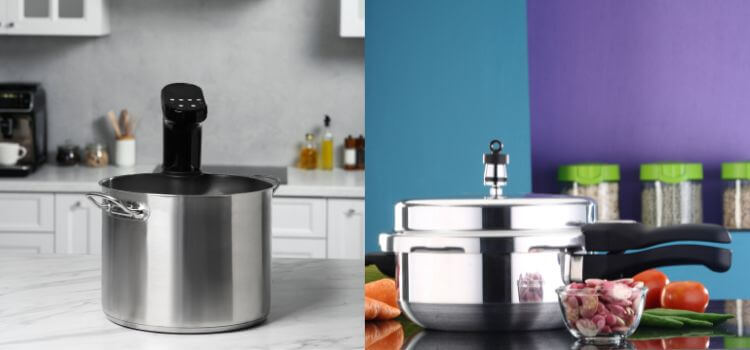As an Amazon Associate, I earn from qualifying purchases

In the world of culinary arts, two appliances have come to the forefront for their unique abilities to transform ingredients into mouthwatering meals: the sous vide and the pressure cooker. Each has its legion of devoted fans, swearing by the results they deliver.
In this article, we delve into the world of sous vide and pressure cooking, comparing their techniques, benefits, and drawbacks. Whether you’re a seasoned home cook or a beginner in the kitchen, this comparison will provide valuable insights to help you decide which appliance deserves a spot on your countertop.
What is a Sous Vide?

Sous vide, a French term meaning “under vacuum,” describes a cooking technique involving sealing food in a bag and immersing it in a precisely controlled water bath for cooking. Gourmet chefs initially used this technique, but with the advent of sous vide machines, it has become more accessible for home cooks.
Sous vide cooking involves slow-cooking food at a steady temperature, yielding impeccably cooked and tender dishes. It’s a gentle cooking method that allows for precise control over the outcome, making it perfect for delicate proteins like fish and eggs.
How it works
To prepare food using the sous vide method, you will need a vacuum sealer to seal the ingredients in airtight bags. The next step is to place these bags in a water bath at a specific temperature, usually controlled by a sous vide machine or immersion circulator.
The meticulous temperature management distinguishes sous vide from alternative cooking techniques. It allows for consistent results as the food cooks evenly from edge to edge, with no risk of overcooking. Cooking times vary from 30 minutes to several hours, influenced by the ingredients and preferred level of doneness.
Pros of Sous Vide Cooking
Temperature control
Sous vide cooking provides meticulous temperature control, ensuring food is cooked consistently and evenly. This makes it perfect for dishes that require a specific level of doneness.
Retention of nutrients and flavors
Since sous vide involves cooking food in sealed bags, there is minimal loss of nutrients and flavors compared to other methods like boiling or grilling.
Enhanced flavor and texture
The slow and gentle cooking method of sous vides results in tender and juicy meats with enhanced flavors. It also allows for infusing ingredients like herbs and spices into the food while it cooks, resulting in a more flavorful dish.
Cons of Sous Vide Cooking
Time-consuming
Sous vide cooking often requires more time compared to conventional methods because of its slow and meticulous cooking process. This might not be the best choice for individuals seeking a fast meal option.
Need for special equipment
To prepare food using the sous vide technique, you’ll require a vacuum sealer along with either a sous vide machine or an immersion circulator. This can be an added expense for home cooks.
Lack of browning and caramelization
Since sous vide cooking involves cooking food in water, there is no opportunity for browning or caramelization. This may result in dishes lacking the traditional crispy exterior.
What is a Pressure Cooker?

A pressure cooker is a tightly sealed pot equipped with a valve to regulate the steam pressure within. It is engineered to rapidly cook food by elevating the boiling point of water, leading to reduced cooking durations.
Pressure cookers have been used for decades, but modern versions come with advanced features and safety mechanisms, making them suitable for home use.
How it works
To cook using a pressure cooker, you will need to add liquid and food to the pot and seal it with a lid. The heat inside the pot creates steam that builds pressure, cooking the food at a higher temperature than traditional methods.
The valve on top of the pressure cooker regulates the amount of steam released, helping maintain a consistent pressure level. The cooking time can range from 10-15 minutes for vegetables to 30 minutes or more for meats and beans.
Pros of Pressure Cooking
Speed and efficiency
Pressure cookers are known for their ability to cook food quickly and efficiently. With the ability to cut cooking times by as much as 70%, they are ideal for busy individuals and families alike.
Retention of nutrients and flavors
Similar to sous vide cooking, pressure cooking is another method that preserves nutrients and flavors exceptionally well. By creating a sealed environment, pressure cooking locks in the natural goodness of the ingredients, resulting in delicious and nutritious meals every time.
Versatility
Pressure cookers are multifaceted kitchen tools capable of preparing an array of dishes, ranging from hearty soups and stews to succulent meats and vegetables.
Cons of Pressure Cooking
Overcooking risks
Since pressure cookers cook food at high temperatures and pressures, there is a risk of overcooking if not closely monitored. This can result in mushy or tough textures.
Limited browning and caramelization
Just like sous vide cooking, pressure cooking cannot also brown and caramelize due to the lack of direct heat. This may result in dishes with a different texture and appearance than traditional methods.
Safety concerns
Although modern pressure cookers come with safety mechanisms, there is still a risk of explosions if not handled properly. It’s essential to follow all instructions and safety precautions when using a pressure cooker.
Sous Vide vs Pressure Cooker: A Comparison

- Time: Sous vide requires longer cooking times with minimal hands-on effort, while pressure cookers need shorter cooking times but more attention.
- Taste: Sous vide brings out enhanced flavors and textures through slow, precise cooking, while pressure cookers retain flavors but might lack some crispiness.
- Texture: Sous vide offers tender, juicy results with a low risk of overcooking, whereas pressure cooking may alter texture due to the absence of browning.
- Versatility: Both methods are versatile, but sous vide is suitable for various foods, including meats and vegetables, while pressure cookers may not be ideal for delicate items like fish.
- Ease of use: Sous vide demands special equipment and knowledge of cooking times, while pressure cookers, though intimidating at first, now come with safety features and clear instructions.
Both techniques excel in quick, efficient cooking that preserves flavors and nutrients. The decision between the two options relies on personal preference and the specific dish being considered. Explore both options to find the one that best fits your preferences and requirements.
Whether you’re in a hurry or aiming to enhance your culinary skills, consider using sous vide or a pressure cooker for a delightful, flavorful meal. Enjoy your cooking adventure!
Conclusion
Sous vide, and pressure cooking is two popular methods that use different techniques to produce delicious meals. While sous vide relies on slow, precise cooking in a controlled environment, pressure cooking uses high heat and pressure to cook food quickly. Both have their benefits and drawbacks, making them suitable for different dishes and preferences.
Whichever method you choose, be sure to follow safety precautions and experiment to find the perfect meals for you and your family. So, whether you’re looking for tender and flavorful meats or quick and efficient meal preparation, both sous vide and pressure cooking have something to offer. The choice between them ultimately comes down to personal preference and the dish at hand. Happy cooking!
As an Amazon Associate, I earn from qualifying purchases
Pingback: How Long To Cook Chitterlings In A Pressure Cooker